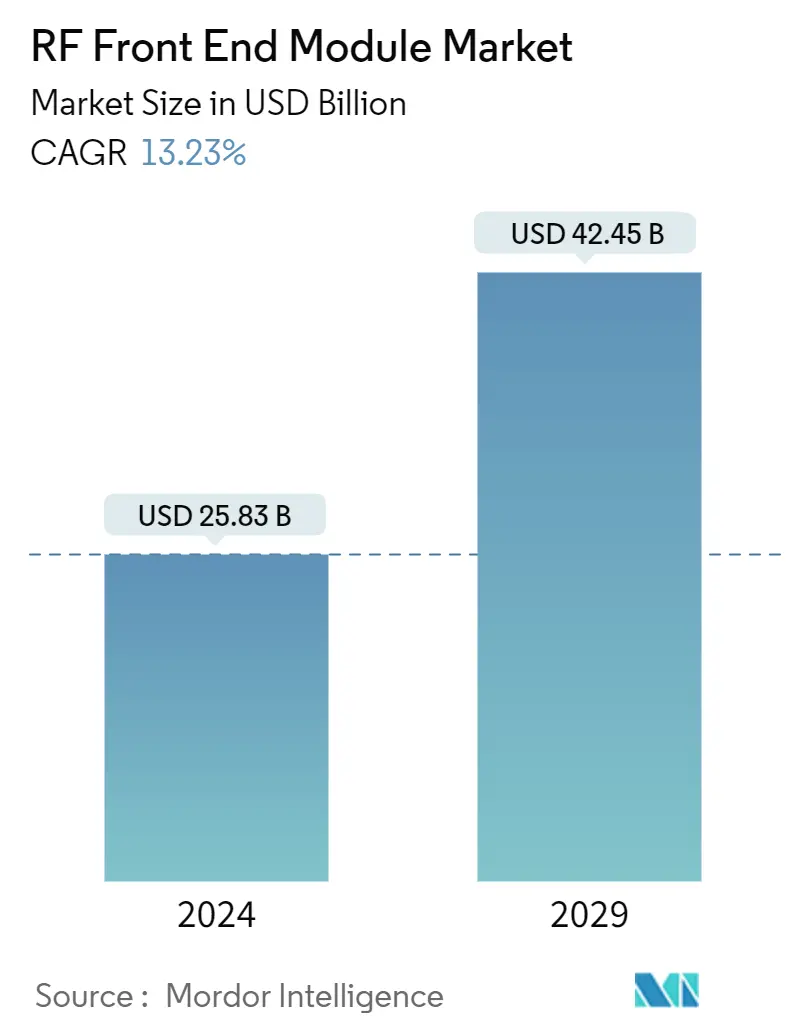Market Size of RF Front End Module Industry

| Study Period | 2019 - 2029 |
| Market Size (2024) | USD 25.83 Billion |
| Market Size (2029) | USD 42.45 Billion |
| CAGR (2024 - 2029) | 13.23 % |
| Fastest Growing Market | Asia Pacific |
| Largest Market | Asia Pacific |
| Market Concentration | Low |
Major Players
*Disclaimer: Major Players sorted in no particular order |
Radio Frequency (RF) Front End Module Market Analysis
The RF Front End Module Market size is estimated at USD 25.83 billion in 2024, and is expected to reach USD 42.45 billion by 2029, growing at a CAGR of 13.23% during the forecast period (2024-2029).
In recent years, the development of low-cost nanosatellites has grown considerably. It has been made viable due to the availability of low-cost launch vectors and "commercial off-the-shelf components" (COTS). Most COTS components are usually not space-qualified, and to make them work and withstand the harsh space environment, they need extra effort in in-circuit redesign and implementation. The RF front-end design is considered one of the better and more feasible choices in expert research, which consists of an S-band transceiver that is fully implemented using COTS components. If further implemented in nanosatellites, the market in this sector shall grow significantly during the forecast period.
- An RF front-end module refers to the circuitry in a radio receiver circuit between a radio receiver's antenna input and the mixer stage or the transmitter's power amplifier.
- The exponential increase in mobile communication devices on a unit basis and rising data traffic due to data-intensive applications have led RF FEM providers to lead innovation, such as high-frequency bands in handsets. Additionally, per the Cisco Visual Networking Index, the global mobile data traffic is expected to increase sevenfold between 2017 and 2022, with a CAGR of 46%, reaching 77.5 exabytes per month by 2022.
- Qorvo introduced the first dual-band front-end module (FEM) for Wi-Fi 6, the SKY85334-11 and SKY85750-11. It is designed ideally for customer premise equipment (CPE), combining the performance required to deliver HD/4K video with the efficiency needed for IoT. Also, by featuring linearity, power dissipation, and efficiency for access points, routers, and gateways, where regulatory, thermals, or Power-over-Ethernet (PoE) limitations demand low current consumption, the modules overlook integration at switching, low-noise amplifier (LNA) with bypass and power amplifier (PA) as applications.
- Moreover, the constant increase in defense budgets in developing and developed nations and the demand for technologically-advanced products in the arsenal of national and international armed forces are expected to further fuel the global market's growth. Military radio frequency and electronic warfare applications are expected to grow in addition to the technological advancements in autonomous vehicles and drones.
- RF power amplifiers (PA), thus, form an integral part of all the base stations for wireless mobile infrastructure. They represent one of the most expensive components of sub-assemblies in modern infrastructure equipment. The GaN RF semiconductors used in these power amplifiers must evolve with the economic and technical realities facing the designers and users of these RF PAs.
- Due to government-imposed lockdowns and travel and trade restrictions, many industries, such as electronics, automotive, aerospace & defense, and telecommunications, were forced to shut down their operations, lowering the demand for RF power semiconductors in 2020. As of 2022, several RF component makers have reorganized their supply chains by working with regional raw material suppliers. In the future, this is projected to reduce the burden of the COVID-19 pandemic on producers.
Radio Frequency (RF) Front End Module Industry Segmentation
The RF front-end module incorporates all the circuitry between the antenna and at least one mixing stage of a receiver and possibly the transmitter's power amplifier.
The RF front-end module market is segmented by component (RF filters, RF switches, RF power amplifiers, and other components), application (consumer electronics, automotive, military, wireless communication, and other applications), and geography (North America (United States, Canada), Europe (Germany, United Kingdom, France, and the rest of Europe), Asia-Pacific (India, China, Japan, and the rest of Asia-Pacifc), and rest of the World (Latin America, Middle East and Africa)). The market sizes and forecasts are provided in terms of value (USD) for all the above segments. Further, the report covers the major vendors in the market and their investments. The report also presents a comprehensive study of the geographical segmentation of the market and the impact of COVID-19 on the market.
| By Component | |
| RF Filters | |
| RF Switches | |
| RF Power Amplifiers | |
| Other Components |
| By Application | |
| Consumer Electronics | |
| Automotive | |
| Military | |
| Wireless Communication | |
| Other Applications |
| By Geography | ||||||
| ||||||
| ||||||
| ||||||
| Rest of the World (Latin America, Middle East and Africa) |
RF Front End Module Market Size Summary
The RF Front End Module (FEM) industry is poised for significant growth, driven by the increasing demand for advanced communication technologies and the proliferation of mobile devices. The market is characterized by rapid innovation, particularly in the development of high-frequency bands for handsets and the integration of RF functionalities in smartphones and tablets. The rise of 5G technology and the growing need for efficient data transmission in mobile computing devices are key factors propelling the market forward. Additionally, the defense sector's expanding budgets and the demand for technologically advanced military applications are further fueling the industry's expansion. The Asia-Pacific region, with its burgeoning consumer electronics market and defense equipment requirements, is expected to witness substantial growth, supported by the flourishing Integrated Circuit (IC) industry and the increasing adoption of Silicon-On-Insulator (SOI) technology in IoT applications.
The RF FEM market is highly competitive, with major players like Broadcom Inc., Skyworks Solutions, Inc., and Murata Manufacturing Co., Ltd. leading the charge in innovation and strategic partnerships. The market's fragmentation is evident as companies continue to introduce new products and expand their portfolios to cater to the evolving needs of the telecommunications and automotive sectors. Notable developments include Qualcomm's launch of Wi-Fi 7 front-end modules and Murata's expansion of millimeter-wave RF front-end solutions for 5G infrastructure. These advancements underscore the industry's commitment to enhancing wireless performance and supporting the growing demand for IoT and automotive applications. As the market evolves, the focus on integrating RF front-end modules into various wireless applications, such as base stations and 5G smartphones, remains a critical driver of growth and innovation.
RF Front End Module Market Size - Table of Contents
-
1. MARKET INSIGHTS
-
1.1 Market Overview
-
1.2 Industry Value Chain Analysis
-
1.3 Industry Attractiveness - Porter's Five Forces Analysis
-
1.3.1 Bargaining Power of Suppliers
-
1.3.2 Bargaining Power of Buyers
-
1.3.3 Threat of New Entrants
-
1.3.4 Threat of Substitutes
-
1.3.5 Intensity of Competitive Rivalry
-
-
1.4 Assessment of the Impact of COVID-19 on the Market
-
-
2. MARKET SEGMENTATION
-
2.1 By Component
-
2.1.1 RF Filters
-
2.1.2 RF Switches
-
2.1.3 RF Power Amplifiers
-
2.1.4 Other Components
-
-
2.2 By Application
-
2.2.1 Consumer Electronics
-
2.2.2 Automotive
-
2.2.3 Military
-
2.2.4 Wireless Communication
-
2.2.5 Other Applications
-
-
2.3 By Geography
-
2.3.1 North America
-
2.3.1.1 United States
-
2.3.1.2 Canada
-
-
2.3.2 Europe
-
2.3.2.1 Germany
-
2.3.2.2 United Kingdom
-
2.3.2.3 France
-
2.3.2.4 Rest of Europe
-
-
2.3.3 Asia-Pacific
-
2.3.3.1 India
-
2.3.3.2 China
-
2.3.3.3 Japan
-
2.3.3.4 Rest of Asia-Pacific
-
-
2.3.4 Rest of the World (Latin America, Middle East and Africa)
-
-
RF Front End Module Market Size FAQs
How big is the RF Front End Module Market?
The RF Front End Module Market size is expected to reach USD 25.83 billion in 2024 and grow at a CAGR of 13.23% to reach USD 42.45 billion by 2029.
What is the current RF Front End Module Market size?
In 2024, the RF Front End Module Market size is expected to reach USD 25.83 billion.

